Abstract
BACKGROUND: Highly active antiretroviral therapies (HAART) increase the CD4(+) cell count, but complete normalization of this parameter has not been obtained in some patients. As oxidative stress plays an important role during human immunodeficiency virus type 1 (HIV-1)-associated dementia and lymphocyte apoptosis, we asked whether the nitric oxide (NO) pathway plays a role in the in vitro survival of peripheral blood mononuclear cells (PBMC) from HIV-1(+) patients and how it correlates with peripheral CD4(+) cell levels. MATERIALS AND METHODS: PBMC were isolated from patients with AIDS and assayed for apoptosis and proliferation in the presence of various chemicals, including agonists or antagonists of the NO pathway. Data were then compared with several in vivo parameters from the same patients. RESULTS: Apoptosis of PBMC in the presence of exogenous NO is significantly higher in patients with low peripheral CD4(+) cell levels than in patients with high CD4(+) cell numbers or seronegative individuals. In addition, endogenous NO inhibition rescues cells from apoptosis in AIDS patients with low circulating CD4(+) cell numbers and helps recovery of the T cell proliferative response. NO-mediated apoptosis does not require cGMP but involves peroxynitrite generation, PARP activation, and NAD(+) depletion. CONCLUSIONS: Taken together, the data suggest the involvement of NO during the apoptosis and functional impairment of lymphocytes in patients with AIDS.
Full text
PDF
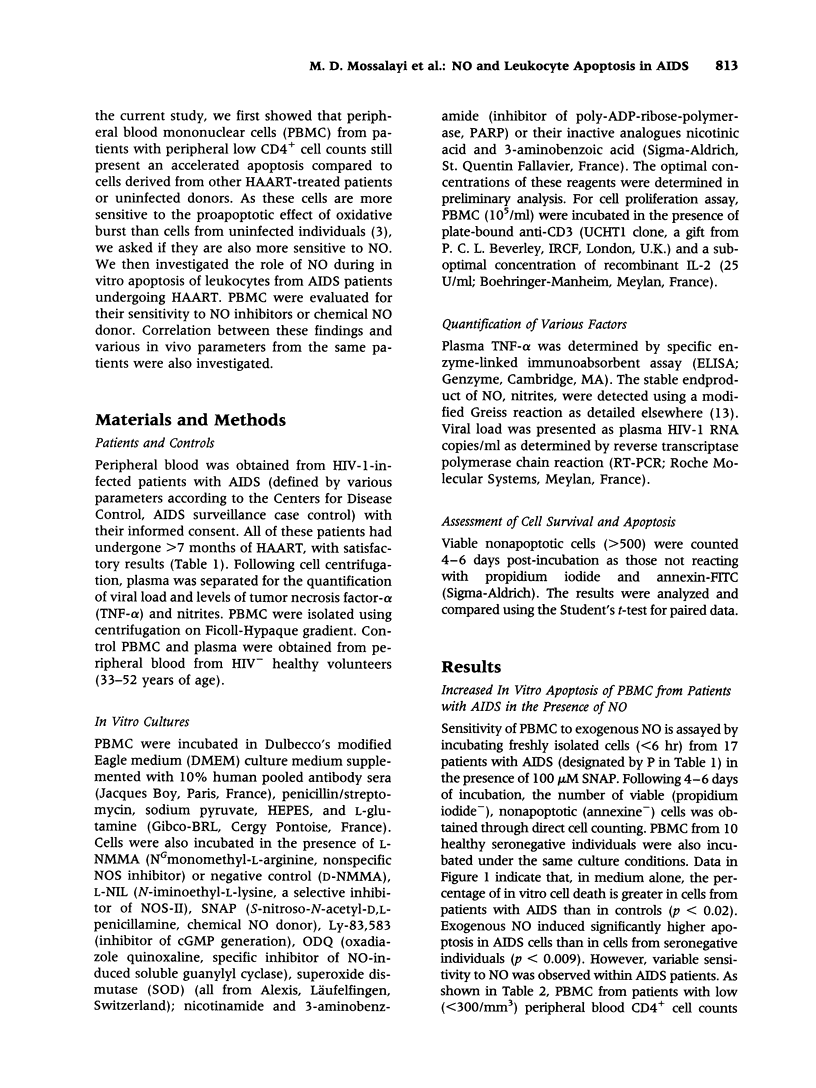
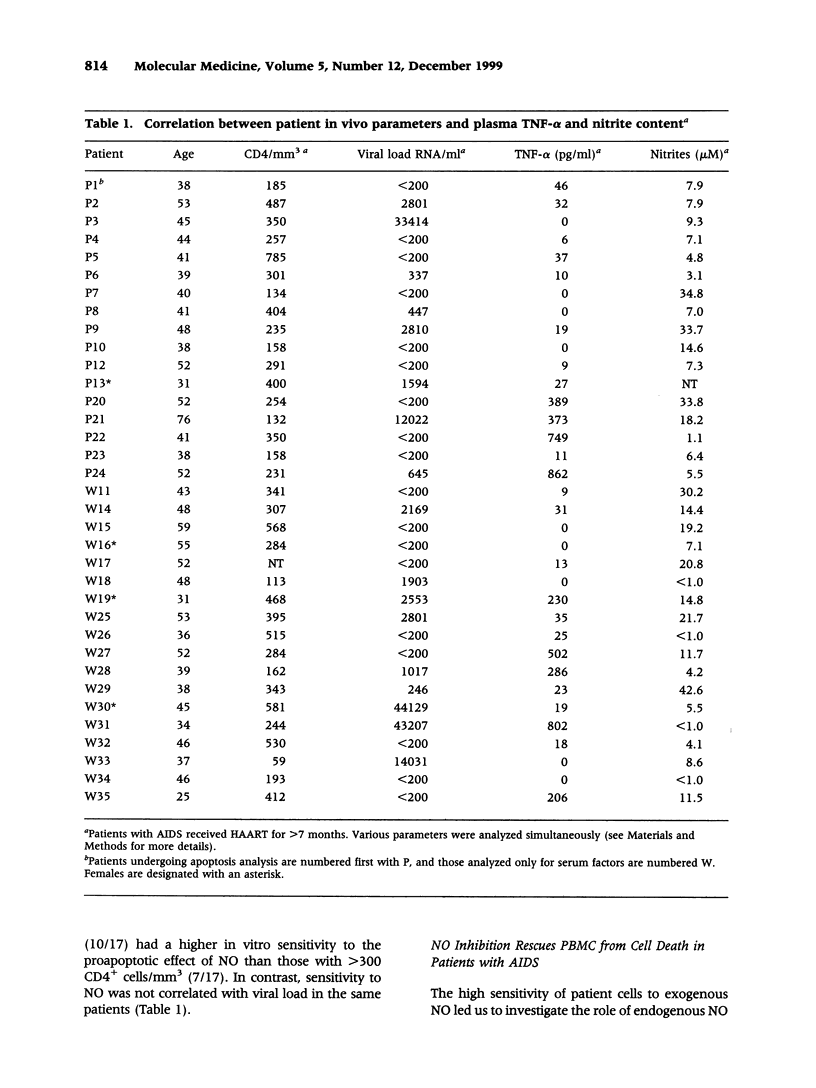

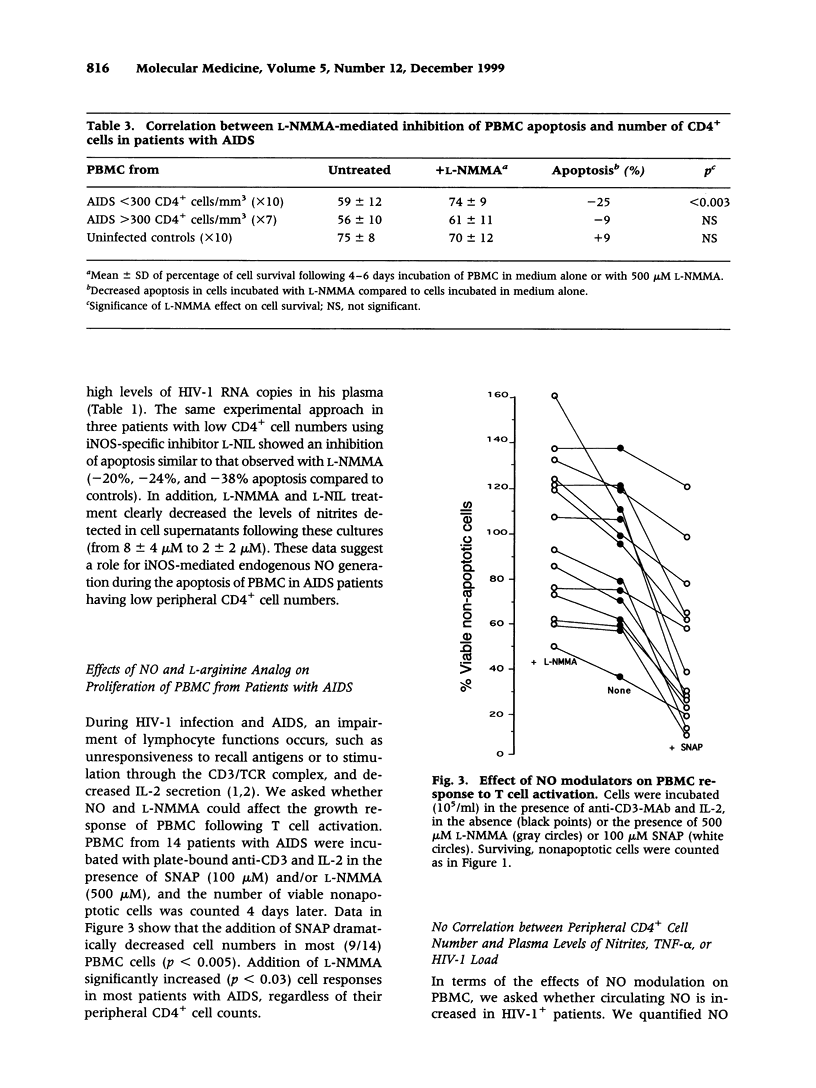
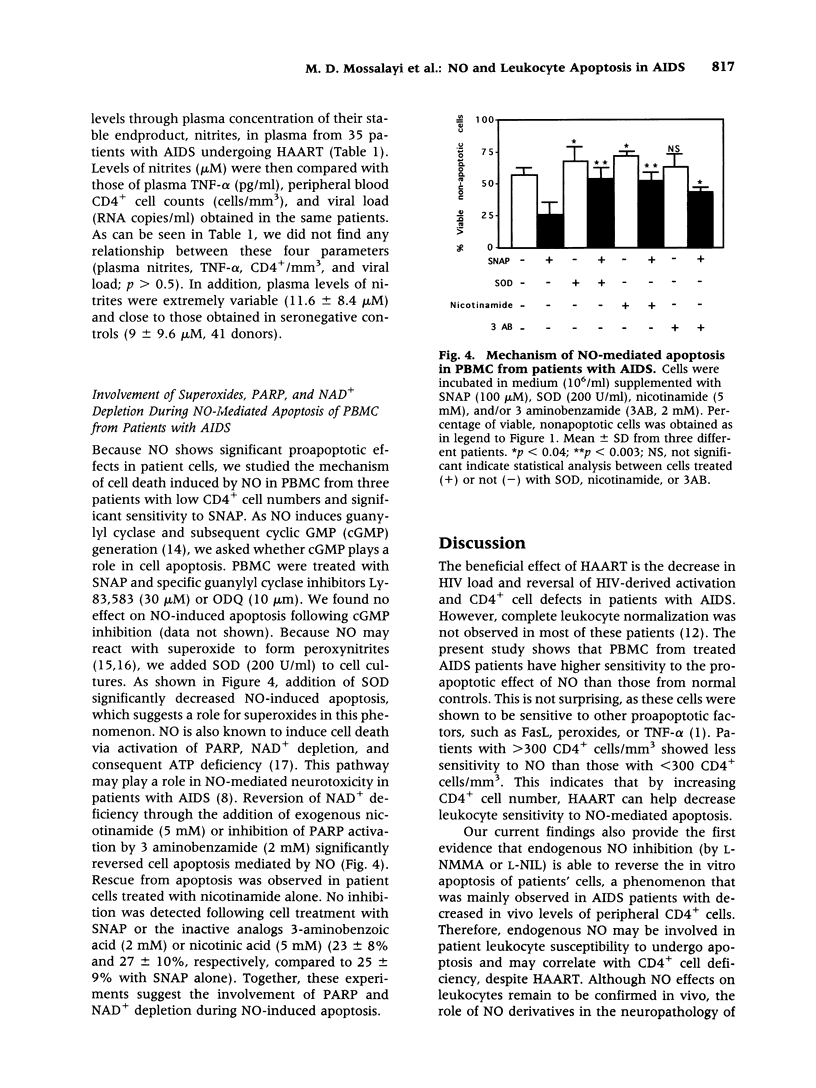
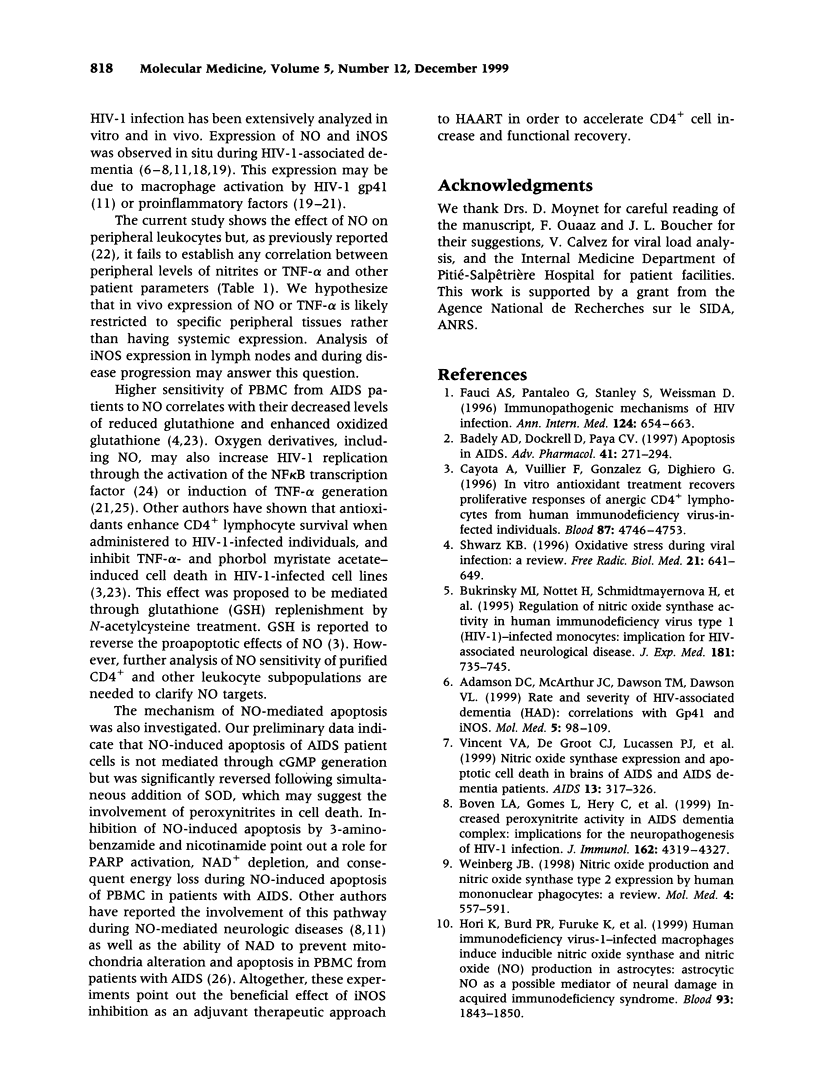

Selected References
These references are in PubMed. This may not be the complete list of references from this article.
- Adamson D. C., McArthur J. C., Dawson T. M., Dawson V. L. Rate and severity of HIV-associated dementia (HAD): correlations with Gp41 and iNOS. Mol Med. 1999 Feb;5(2):98–109. [PMC free article] [PubMed] [Google Scholar]
- Adamson D. C., Wildemann B., Sasaki M., Glass J. D., McArthur J. C., Christov V. I., Dawson T. M., Dawson V. L. Immunologic NO synthase: elevation in severe AIDS dementia and induction by HIV-1 gp41. Science. 1996 Dec 13;274(5294):1917–1921. doi: 10.1126/science.274.5294.1917. [DOI] [PubMed] [Google Scholar]
- Arnold W. P., Mittal C. K., Katsuki S., Murad F. Nitric oxide activates guanylate cyclase and increases guanosine 3':5'-cyclic monophosphate levels in various tissue preparations. Proc Natl Acad Sci U S A. 1977 Aug;74(8):3203–3207. doi: 10.1073/pnas.74.8.3203. [DOI] [PMC free article] [PubMed] [Google Scholar]
- Autran B., Carcelain G., Li T. S., Blanc C., Mathez D., Tubiana R., Katlama C., Debré P., Leibowitch J. Positive effects of combined antiretroviral therapy on CD4+ T cell homeostasis and function in advanced HIV disease. Science. 1997 Jul 4;277(5322):112–116. doi: 10.1126/science.277.5322.112. [DOI] [PubMed] [Google Scholar]
- Badley A. D., Dockrell D., Paya C. V. Apoptosis in AIDS. Adv Pharmacol. 1997;41:271–294. doi: 10.1016/s1054-3589(08)61062-5. [DOI] [PubMed] [Google Scholar]
- Boven L. A., Gomes L., Hery C., Gray F., Verhoef J., Portegies P., Tardieu M., Nottet H. S. Increased peroxynitrite activity in AIDS dementia complex: implications for the neuropathogenesis of HIV-1 infection. J Immunol. 1999 Apr 1;162(7):4319–4327. [PubMed] [Google Scholar]
- Bukrinsky M. I., Nottet H. S., Schmidtmayerova H., Dubrovsky L., Flanagan C. R., Mullins M. E., Lipton S. A., Gendelman H. E. Regulation of nitric oxide synthase activity in human immunodeficiency virus type 1 (HIV-1)-infected monocytes: implications for HIV-associated neurological disease. J Exp Med. 1995 Feb 1;181(2):735–745. doi: 10.1084/jem.181.2.735. [DOI] [PMC free article] [PubMed] [Google Scholar]
- Bukrinsky M., Schmidtmayerova H., Zybarth G., Dubrovsky L., Sherry B., Enikolopov G. A critical role of nitric oxide in human immunodeficiency virus type 1-induced hyperresponsiveness of cultured monocytes. Mol Med. 1996 Jul;2(4):460–468. [PMC free article] [PubMed] [Google Scholar]
- Bécherel P. A., Chosidow O., Le Goff L., Francès C., Debré P., Mossalayi M. D., Arock M. Inducible nitric oxide synthase and proinflammatory cytokine expression by human keratinocytes during acute urticaria. Mol Med. 1997 Oct;3(10):686–694. [PMC free article] [PubMed] [Google Scholar]
- Cayota A., Vuillier F., Gonzalez G., Dighiero G. In vitro antioxidant treatment recovers proliferative responses of anergic CD4+ lymphocytes from human immunodeficiency virus-infected individuals. Blood. 1996 Jun 1;87(11):4746–4753. [PubMed] [Google Scholar]
- Darley-Usmar V. M., Hogg N., O'Leary V. J., Wilson M. T., Moncada S. The simultaneous generation of superoxide and nitric oxide can initiate lipid peroxidation in human low density lipoprotein. Free Radic Res Commun. 1992;17(1):9–20. doi: 10.3109/10715769209061085. [DOI] [PubMed] [Google Scholar]
- Fauci A. S., Pantaleo G., Stanley S., Weissman D. Immunopathogenic mechanisms of HIV infection. Ann Intern Med. 1996 Apr 1;124(7):654–663. doi: 10.7326/0003-4819-124-7-199604010-00006. [DOI] [PubMed] [Google Scholar]
- Gendelman H. E., Zheng J., Coulter C. L., Ghorpade A., Che M., Thylin M., Rubocki R., Persidsky Y., Hahn F., Reinhard J., Jr Suppression of inflammatory neurotoxins by highly active antiretroviral therapy in human immunodeficiency virus-associated dementia. J Infect Dis. 1998 Oct;178(4):1000–1007. doi: 10.1086/515693. [DOI] [PubMed] [Google Scholar]
- Hermann E., Idziorek T., Kusnierz J. P., Mouton Y., Capron A., Bahr G. M. Role of nitric oxide in the regulation of lymphocyte apoptosis and HIV-1 replication. Int J Immunopharmacol. 1997 Jul;19(7):387–397. doi: 10.1016/s0192-0561(97)00060-x. [DOI] [PubMed] [Google Scholar]
- Hori K., Burd P. R., Furuke K., Kutza J., Weih K. A., Clouse K. A. Human immunodeficiency virus-1-infected macrophages induce inducible nitric oxide synthase and nitric oxide (NO) production in astrocytes: astrocytic NO as a possible mediator of neural damage in acquired immunodeficiency syndrome. Blood. 1999 Mar 15;93(6):1843–1850. [PubMed] [Google Scholar]
- Koka P., He K., Zack J. A., Kitchen S., Peacock W., Fried I., Tran T., Yashar S. S., Merrill J. E. Human immunodeficiency virus 1 envelope proteins induce interleukin 1, tumor necrosis factor alpha, and nitric oxide in glial cultures derived from fetal, neonatal, and adult human brain. J Exp Med. 1995 Oct 1;182(4):941–951. doi: 10.1084/jem.182.4.941. [DOI] [PMC free article] [PubMed] [Google Scholar]
- Nuovo G. J., Alfieri M. L. AIDS dementia is associated with massive, activated HIV-1 infection and concomitant expression of several cytokines. Mol Med. 1996 May;2(3):358–366. [PMC free article] [PubMed] [Google Scholar]
- Ouaaz F., Ruscetti F. W., Dugas B., Mikovits J., Agut H., Debré P., Mossalayi M. D. Role of IgE immune complexes in the regulation of HIV-1 replication and increased cell death of infected U1 monocytes: involvement of CD23/Fc epsilon RII-mediated nitric oxide and cyclic AMP pathways. Mol Med. 1996 Jan;2(1):38–49. [PMC free article] [PubMed] [Google Scholar]
- Pieper A. A., Verma A., Zhang J., Snyder S. H. Poly (ADP-ribose) polymerase, nitric oxide and cell death. Trends Pharmacol Sci. 1999 Apr;20(4):171–181. doi: 10.1016/s0165-6147(99)01292-4. [DOI] [PubMed] [Google Scholar]
- Roederer M., Ela S. W., Staal F. J., Herzenberg L. A., Herzenberg L. A. N-acetylcysteine: a new approach to anti-HIV therapy. AIDS Res Hum Retroviruses. 1992 Feb;8(2):209–217. doi: 10.1089/aid.1992.8.209. [DOI] [PubMed] [Google Scholar]
- Savarino A., Martini C., Orofino G. C., Cantamessa C., Castelli L., Pich P. G., Sinicco A., Pugliese A. Apoptotic DNA fragmentation, and its in vitro prevention by nicotinamide, in lymphocytes from HIV-1-seropositive patients and in HIV-1-infected MT-4 cells. Cell Biochem Funct. 1997 Sep;15(3):171–179. doi: 10.1002/(SICI)1099-0844(199709)15:3<171::AID-CBF736>3.0.CO;2-A. [DOI] [PubMed] [Google Scholar]
- Schreck R., Rieber P., Baeuerle P. A. Reactive oxygen intermediates as apparently widely used messengers in the activation of the NF-kappa B transcription factor and HIV-1. EMBO J. 1991 Aug;10(8):2247–2258. doi: 10.1002/j.1460-2075.1991.tb07761.x. [DOI] [PMC free article] [PubMed] [Google Scholar]
- Vincent V. A., De Groot C. J., Lucassen P. J., Portegies P., Troost D., Tilders F. J., Van Dam A. M. Nitric oxide synthase expression and apoptotic cell death in brains of AIDS and AIDS dementia patients. AIDS. 1999 Feb 25;13(3):317–326. doi: 10.1097/00002030-199902250-00003. [DOI] [PubMed] [Google Scholar]
- Weinberg J. B. Nitric oxide production and nitric oxide synthase type 2 expression by human mononuclear phagocytes: a review. Mol Med. 1998 Sep;4(9):557–591. doi: 10.1007/BF03401758. [DOI] [PMC free article] [PubMed] [Google Scholar]
- Xia Y., Dawson V. L., Dawson T. M., Snyder S. H., Zweier J. L. Nitric oxide synthase generates superoxide and nitric oxide in arginine-depleted cells leading to peroxynitrite-mediated cellular injury. Proc Natl Acad Sci U S A. 1996 Jun 25;93(13):6770–6774. doi: 10.1073/pnas.93.13.6770. [DOI] [PMC free article] [PubMed] [Google Scholar]


